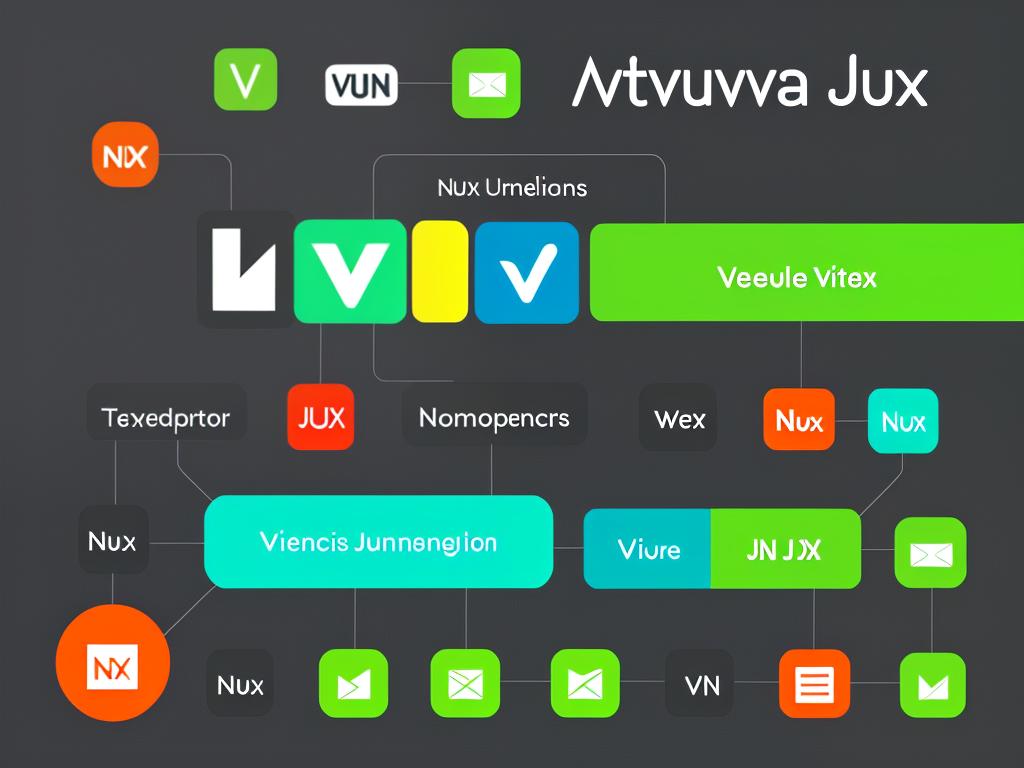
In an ever-evolving digital world, mastering cutting-edge technologies gives software enthusiasts a competitive edge in the industry. Among numerous programming frameworks, Vue Js, Nuxt Js, Nuxt 3, and Nest Js have distinguished themselves as principal tools in developing efficient and scalable applications. As such, this spirited exploration is aimed at demystifying the concepts, applications, and integration techniques of these modern programming frameworks. It provides budding developers, enthusiasts, and hobbyists with practical examples and a comprehensive understanding needed to harness these tools for more effective full-stack development.
Understanding Vue Js and Nuxt Js
Understanding Vue Js and Nuxt Js
Vue Js and Nuxt Js are frameworks for developing user interfaces. Vue Js is a JavaScript framework used for building user interfaces, while Nuxt Js is a Vue Js framework providing in-depth features for production-grade web development.
Vue Js allows developers to extend HTML with HTML attributes known as directives. It provides two-way data binding, server-side rendering, Vue-CLI, and optional JSX support. As a progressive framework, it allows developers to adopt any part of it gradually until they are fully comfortable with the ecosystem.
Nuxt Js, on the other hand, simplifies the development of universal or single-page Apps with Vue Js. It includes features, such as async data loading, middleware, and automatic code splitting, to make web development smoother and more accessible.
Setting Up Vue Js and Nuxt Js
Setting up a Vue Js project can be done quickly using Vue CLI, a command-line tool. To install Vue CLI, you need to have Node.js and npm installed on your machine. After that, you can install Vue CLI globally on your machine by running npm install -g @vue/cli in your terminal. You can then create a new project by running vue create project-name.
Installing Nuxt Js is just as straightforward. You need to have Node.js (version 10.13 or newer) installed on your machine. You can create a new Nuxt Js project by running npx create-nuxt-app project-name in your terminal.
Building Simple Applications
Both Vue Js and Nuxt Js provide intuitive and straightforward APIs for building web applications. In a Vue Js app, you can declare your application’s data and methods in an instance of the Vue constructor, then bind elements in your HTML to data in your Vue instance using directives.
In a Nuxt Js application, a typical project structure includes a pages directory for your application’s views and routes, a static directory for static files, and a components directory for Vue components. Nuxt Js also provides a built-in Axios module for making HTTP requests, and a Vuex store for state management.
Transitioning to Nuxt 3 and Nest Js
If you’re already familiar with Nuxt Js, transitioning to Nuxt 3 would be a valuable next step. Nuxt 3 has improved build performance, better TypeScript integration, and a new composition API.
On the other hand, Nest Js is a Node.js framework for building scalable server-side applications. It uses progressive JavaScript and is built with TypeScript, but still preserves compatibility with JavaScript. Understanding Vue Js and Nuxt Js would provide a valuable context for transitioning to running your own scalable applications with Nest Js. Techniques like building HTTP servers, understanding modular structures, and implementing authentication are just some key skills to be developed.
Diving into the realm of programming tools such as Vue Js, Nuxt Js, Nuxt 3, and Nest Js can be a game-changer for any developer. The proficient use of Vue Js and Nuxt Js lays a solid foundation for further exploration into the advanced territories of Nuxt 3 and Nest Js. Harnessing these tools can provide a remarkable edge in your development projects.

Getting to Grips with Nuxt 3
Introduction to Nuxt 3
The advent of Nuxt 3, a product from the creators of Vue.js, has brought a fresh wave in the Vue.js applications development landscape. It stands as an upgraded framework, promising an expanded and seamless user experience in comparison to Nuxt 2. Incorporating the improvements of Vue 3 and new composables, Nuxt 3 is a reliable base for building resilient applications. Its noteworthy feature is its automatic server-side rendering (SSR) capabilities, marking a noteworthy step forward in terms of performance and SEO optimization.
Working with Vue 3
Vue.js, the JavaScript framework used to develop user interfaces, has evolved significantly with its third version, Vue 3. Nuxt 3 leverages these improvements to fine-tune its performance and developer experience. Vue 3 introduces the Composition API, opening up more options for code organization. It supports TypeScript for better type safety and developer tooling, and the Vue 3’s Teleport Component offers improved flexibility for rendering elements in different parts of the DOM.
Server-side Rendering (SSR)
One of the core features of Nuxt.js is its out-of-the-box server-side rendering (SSR). SSR refers to the ability of an application to contribute directly to the HTML on the initial server response. With SSR, when a user makes a request to your web app, the server will render the requested page and deliver it to the user fully formed. The main advantages of this are faster page loading times, better performance, and improved SEO as search engines will be able to better index servers rendered pages.
New Composables
Nuxt 3 introduces a new set of composables that provide low-level access to the Nuxt.js core functions. This new set includes useNuxt, useFetch, useRouter, useMeta, useAsyncData, among others. These composables offer more modularity to your code and are better suited for TypeScript support, which is a notable upgrade on Nuxt.js.
Building an Application with Nuxt 3
When creating an application with Nuxt 3, developers can make use of its Vue 3 support, next-gen static site generation, Nitro engine, and server components. They can also leverage its file-based routing and collection of default conventions to create projects faster. In the process, developers can take advantage of Vue components, state management, and Vue Router with less configuration on their part.
Nest Js and Nuxt 3
Nest js is a framework for creating efficient, scalable Node.js server-side applications. It uses progressive JavaScript and supports TypeScript out of the box. When combined with Nuxt 3, developers can create performant, secure, and powerful applications. Nest Js’s modular architecture works well with the Nuxt.js ecosystem, improving the structure of server-side applications.
Nuxt Js and Vue Js Interplay
Nuxt.js is a framework built on Vue.js and offers all the benefits of Vue.js along with additional features that can simplify application development. Features such as static site generation, automatic code splitting, and one-source data fetch make Nuxt.js a powerful tool when paired with Vue.js.
In conclusion, Nuxt 3 not only embraces the enhancements of Vue 3, but also enriches it by offering additional improvements and features beneficial for application development. This makes it a strong choice whether you’re creating server-rendered apps, single-page apps, or static sites. Specifically, Nuxt 3’s integration with other innovative tools and technologies including Nest Js, further extends its application and utility in diverse scenarios.

Getting Started with Nest Js
Further Exploring Nest JS
Moving on from Nuxt 3, let’s now delve into Nest Js, another robust and progressive Node.js framework primed for building efficient and scalable server-side applications. Nest Js builds on the capabilities of Express. This gives it an upper hand in supporting both REST and GraphQL APIs. Notably, it is fully compatible with TypeScript, thereby allowing you to exploit advanced features of JavaScript. Nest Js is known for its modular architecture which champions clean code organization through defined separation of responsibilities. One of the striking features of Nest Js is its support for out-of-the-box application architecture. This empowers developers to create applications that are not only highly testable and scalable, but also loosely-coupled.
Setting Up a Nest JS Project
To get started with Nest JS, you first need to install Node.js and npm on your machine. Once that’s done, setting up a new Nest JS project is a breeze with the following command: npx @nestjs/cli new project-name. This will bootstrap a new project and automatically install all required dependencies.
When structuring your Nest JS project, the essential pieces include modules, controllers, and providers. Modules are used to package related functionalities together. Controllers handle incoming request and send out responses. Providers can be services, repositories, factories, and values that could be injected to controllers and other providers.
Adding Authentication and Routing in Nest JS
Nest JS offers comprehensive functionalities for authentication and routing. For authentication, the @nestjs/passport module provides a set of decorators, guards, and strategies that integrate with the popular Passport.js library. It supports JWT, local (username and password), OAuth2, etc.
As for routing, Nest JS uses decorators like @Controller, @Get, @Post, etc. to manage routes. For example, @Controller(‘todos’) indicates that a controller handles routes that start with /todos. The method decorators like @Get(), @Post() would handle GET and POST requests respectively.
CRUD Operations with Nest Js
Building a CRUD (Create, Read, Update, Delete) application with Nest Js is quite straightforward. Typically, you would define a service that interacts with a database for CRUD operations, and a controller that uses the service to handle HTTP requests. Nest JS supports various databases (SQL or NoSQL) with its @nestjs/typeorm module which is a wrapper around TypeORM.
Integrating Nest Js with Nuxt.js and Vue.js
Both Nuxt.js and Vue.js are popular choices for frontend development. The integration of Nest Js with these libraries provides a full stack solution. One common approach would be to use Nuxt.js for server-side rendering and static site generation, and Vue.js for the interactive client-side, utilizing Vue’s reactive UI abilities and components. In such architectures, Nest Js acts as the backend, handling business logic, database interactions, and providing APIs to the frontend.
Introduction to Nuxt.js 3 and Vue.js 3
Nuxt.js 3 and Vue.js 3 are the latest versions of these technologies. They introduce many new features including a Composition API, improved performance, and better TypeScript support. Developers who want to leverage these improvements should definitely consider learning and adapting these versions.
Conclusion
Finishing off, Nest Js serves as a robust framework for curating efficient, scalable software. When integrated with front-end libraries like Nuxt.js and Vue.js, it presents a comprehensive full-stack solution enabling the creation of diverse web applications, from small-scale projects to large enterprise systems.

Photo by lautaroandreani on Unsplash
Integration of Nuxt Js with Nest Js
Comprehending Nuxt 3, Vue Js, and Nuxt Js
Nuxt Js operates as a Vue Js framework designed to create server-side rendered (SSR) applications. It simplifies the overall configuration and setup process associated with Vue Js, leading to a seamless development journey. Nuxt Js comes packed with perks like pre-configured setup for Vuex (an avenue for state management), Vue Router (for routing), and Vue Meta (for managing HTML meta tags), among others.
Standing as the newest iteration, Nuxt 3 introduces several upgrades and features over its predecessor. These include enhanced build performance, an improved developer experience, a more lightweight runtime, superior TypeScript integration, and support for Vue 3 with accompanying features such as the Composition API.
Meanwhile, Vue Js acts as a JavaScript framework for developing single-page applications (SPAs). Its selling points include an easy learning curve, flexibility, high performance, and widespread community support.
Aligning more towards server-side applications built with Node.js, Nest Js is written in TypeScript. Its modular nature ensures easy adaptability. It borrows concepts such as decorators from Angular, rendering it an appropriate choice for developers concurring with Angular.
Integrating Nuxt Js with Nest Js
When integrating Nuxt Js with Nest Js, Nest Js acts as the backend API while Nuxt Js helps to build the frontend. This combination allows for robust full-stack development, taking advantage of the best features of both frameworks.
Firstly, create a new Nest Js application using the Nest CLI and then set up a new Nuxt Js application. After both apps are set up, the Nest Js app will expose some API routes (normally via Express or Fastify), which the Nuxt Js app can consume.
To handle sessions and state management, Vuex store in Nuxt Js application can be leveraged. Vuex is a state management pattern and library for Vue.js applications. It serves as a centralized store for all the components in an application.
You can handle sessions in Nuxt Js using the nuxt/session module or similar libraries. When a user logs in, a session is created, and when they log out, the session is destroyed. The sessions can be stored on the server using various methods such as in-memory store, or databases like PostgreSQL, MongoDB, Redis, etc.
Building Secure Applications with Nuxt Js and Nest Js
Security should be a top priority in any application. Nest Js and Nuxt Js both come with built-in features and utilities to help secure your application. Nest Js has a robust Authentication and Authorization mechanism that, when combined with Express or Fastify middleware, can secure your backend. Furthermore, it allows for integration with Passport.js, a popular authentication middleware for Node.js.
Nuxt Js, on the other hand, provides basic protection out of the box against cross-site scripting (XSS) and other common attacks. The nuxtjs/auth module can be integrated for authentication and protecting routes, while nuxtjs/axios module allows secure HTTP communication between the client and the server. Modules like helmet can also be used to secure Express apps by setting various HTTP headers.
It’s essential not only to use these features but also to follow best practices for robust security. Always sanitize user input and be diligent with use of data from third-party APIs. Implement strict session management and ensure secure communication between client and server.
Remember, while both Nest Js and Nuxt Js provide great tools and utilities, the security of your application ultimately depends on how effectively these tools are used and the overall architecture of your application.

Photo by photosbykrishp on Unsplash
This exploration has provided a comprehensive guide into the applications, techniques, and integrations of Vue Js, Nuxt Js, Nuxt 3, and Nest Js. As software development keeps evolving, staying on top of the latest technologies becomes a necessity. Having delved into the specifics of setting up each of these frameworks and on developing basic applications, the journey takes a leap into integrating Nuxt Js with Nest Js for full-stack development. With this knowledge and the practical examples showcased, enthusiasts are equipped to develop effective and high performing applications across different industry needs. In the world of constant innovation, the key remains in continuous learning and harnessing the power of these technologies to continually better our digital world.



